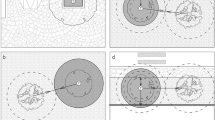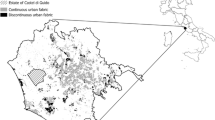Abstract
Urban afforestation improves life quality in urban centers providing social and environmental benefits. Understanding growth of urban trees exposed to air pollution will support planning, managing and expanding urban areas. This approach intends to determine growth patterns of urban trees to support future urban planning. Non-destructive samples were collected from trees of Araucaria angustifolia (Bertol.) Kuntze in Araucaria city, Parana State, Brazil. Growth rings were related to pollutant concentrations and meteorological series. Growth reduction was observed except in the border areas of the city. Trees established during or after the period of industrialization incentives were most affected by air pollution, indicating that immature plants are more vulnerable. Sulphur dioxide and nitric oxide significantly affected growth of smaller trees. Those greater than 60 cm dbh did not demonstrate significant correlation with any identified pollutant. As the trees established before accentuated urbanization were less affected by air pollution, it is reinforced the importance of preserving remaining urban trees. We suggest that planning urban afforestation should precede industries placing. When urban planning is impossible, new planted trees should not be expected to grow as in free pollution areas, but they will still present satisfactory diameter increment, contributing to improve local urban environment.






Similar content being viewed by others
References
Alcalá J, Sosa M, Moreno M, Rodríguez JC, Loredo C, Lara JL, Tapia J (2009) Concentraciones de Fe, Mn y Mg en material foliar de cinco especies arbóreas indicadoras de la contaminación urbana en la ciudad de Chihuahua, México. Multequina 18(1):37–51
Ashby WC, Fritts HC (1972) Tree growth, air pollution, and climate near LaPorte, Ind. Bull Am Meteorol Soc 53(3):246–251. doi:10.1175/1520-0477(1972)053<0246:TGAPAC>2.0.CO;2
Baes CF, McLaughlin SB (1984) Trace elements in tree rings: evidence of recent and historical air pollution. Science 224(4648):494–497
Bartens J, Grissino-Mayer HD, Day SD, Wiseman PE (2012) Evaluating the potential for dendrochronological analysis of live oak (Quercus virginiana mill.) from the urban and rural environment — an explorative study. Dendrochronologia 30(1):15–21. doi:10.1016/j.dendro.2011.04.002
Brack CL (2002) Pollution mitigation and carbon sequestration by an urban forest. Environ Pollut 116:195–200. doi:10.1016/S0269-7491(01)00251-2
Brasil (1990) Resolução/CONAMA/N° 003 de 28 de junho de 1990. http://www.mma.gov.br/port/conama/res/res90/res0390.html Accessed 08 november 2016
Brasil (2008) Lista Oficial das Espécies da Flora Brasileira Ameaçadas de Extinção. Instrução Normativa n° 6 de 23 de setembro de 2008 http://www.mma.gov.br/estruturas/179/_arquivos/179_05122008033615.pdf Accessed 08 november 2016
Brienen RJ, Zuidema PA, During HJ (2006) Autocorrelated growth of tropical forest trees: unraveling patterns and quantifying consequences. For Ecol Manag 237(1):179–190. doi:10.1016/j.foreco.2006.09.042
Brunekreef B, Holgate ST (2002) Air pollution and health. Lancet 360(9341):1233–1242. doi:10.1016/S0140-6736(02)11274-8
Burkhart HE, Tomé M (2012) Modeling forest trees and stands. Springer Science & Business Media 457 pp
Bussotti F, Ferretti M (1998) Air pollution, forest condition and forest decline in southern Europe: an overview. Environ Pollut 101(1):49–65. doi:10.1016/S0269-7491(98)00039-6
Danni-Oliveira IM (2008) Poluição do ar como causa de morbidade e mortalidade da população urbana. Raega-O Espaço Geográfico em Análise 15:113–126. doi:10.5380/raega.v15i0.14249
Davison AC, Hinkley DV (1997) Bootstrap methods and their applications, Cambridge series in statistical and probabilistic mathematics 582 pp
Embrapa (1984) Levantamento de reconhecimento dos solos do Estado do Paraná. Londrina: EMBRAPA-SNLCS/IAPAR 2v 791 pp
Escobedo FJ, Wagner JE, Nowak DJ, Maza CL, Rodriguez M, Crane DE (2008) Analyzing the cost effectiveness of Santiago, Chile's policy of using urban forests to improve air quality. J Environ Manag 86(1):148–157. doi:10.1016/j.jenvman.2006.11.029
Flagan RC, Seinfeld JH (2012) Fundamentals of air pollution engineering. Courier corporation 542 pp
Fritts HC (2012) Tree rings and climate. Elsevier 567 pp
Hermida GC (2015) Agroforesteria periurbana una opción para la producción sustentable en los alrededores de Buenos Aires. Revista Scientia Agroalimentaria 2(1):7–17
Hess AF, Schneider PR, Finger CAG (2009) Crescimento em diâmetro de Araucaria angustifolia (Bertol.) Kuntze em função da idade, em três regiões do Rio Grande do Sul. Ciência Florestal 19(1):7–22
Hirano T, Morimoto K (1999) Growth reduction of the Japanese black pine corresponding to an air pollution episode. Environ Pollut 106(1):5–12. doi:10.1016/S0269-7491(99)00063-9
IAP (2008) Instituto ambiental do Paraná. Lista oficial de espécies da flora ameaçadas de extinção no Paraná. Procedimento Operacional Padrão N° 5 de 20 de junho de 2008
Kampa M, Castanas E (2008) Human health effects of air pollution. Environ Pollut 151(2):362–367. doi:10.1016/j.envpol.2007.06.012
Katz M (1949) Sulfur dioxide in atmosphere and its relation to plant life. Industrial Engineering Chemistry 41(11):2450–2465. doi:10.1021/ie50479a025
Kawamura H, Matsuoka N, Momoshima N, Koike M, Takashima Y (2006) Isotopic evidence in tree rings for historical changes in atmospheric sulfur sources. Environmental science technology 40(18):5750–5754. doi:10.1021/es060321w
Küchelmeister G (2000) Trees for the urban millennium: urban forestry update. Unasylva (FAO) 51:49–55
Long RP, Davis DD (1999) Growth variation of white oak subjected to historic levels of fluctuating air pollution. Environ Pollut 106(2):193–202. doi:10.1016/S0269-7491(99)00077-9
Malik I, Danek M, Marchwińska-Wyrwał E, Danek T, Wistuba M, Krąpiec M (2012) Scots pine (Pinus sylvestris L.) growth suppression and adverse effects on human health due to air pollution in the upper Silesian Industrial District (USID), southern Poland. Water, Air, Soil Pollution 223(6):3345–3364. doi:10.1007/s11270-012-1114-8
de Mattos PP, Braz EM, Domene VD, Sampaio EVDSB, Gasson P, Pareyn FGC, Araújo EDL (2015) Climate tree growth relationships of Mimosa tenuiflora in seasonally dry tropical forest, Brazil. Cerne 21(1):141–149. doi:10.1590/01047760201521011460
de Mattos PP, dos Santos AT, de Oliveira YMM, Rosot MAD (2007a) Dendrocronologia de espécies da Floresta Ombrófila Mista do Município de Candói, PR. Pesquisa Florestal Brasileira 54:153–156
de Mattos PP, dos Santos AT, Rivera H, de Oliveira YMM, Rosot MAD, Garrastazu MC (2007b) Crescimento de Araucaria angustifolia na Reserva Florestal Embrapa/Epagri, Caçador, SC. Pesquisa Florestal Brasileira 55:107–114
de Mattos PP, Oliveira MF, Agustini AF, Braz EM, Rivera H, de Oliveira YMM, Garrastazu MC (2010) Aceleração do crescimento em diâmetro de espécies da Floresta Ombrófila Mista nos últimos 90 anos. Pesquisa Florestal Brasileira 30(64):319–326. doi:10.4336/2010.pfb.30.64.319
McLaughlin SB (1985) Effects of air pollution on forests - a critical review. Journal of the Air Pollution Control Association 35(5):512–534. doi:10.1080/00022470.1985.10465928
McLaughlin SB, Shortle WC, Smith KT (2002) Dendroecological applications in air pollution and environmental chemistry: research needs. Dendrochronologia 20(1):133–157. doi:10.1078/1125-7865-00013
McLaughlin SB, Bräker OU (1985) Methods for evaluating and predicting forest growth responses to air pollution. Experientia 41(3):310–319. doi:10.1007/BF02004491
McPherson EG, Peper PJ (2012) Urban tree growth modeling. Arboricult Urban For 38(5):175–183
Muzika RM, Guyette RP, Zielonka T, Liebhold AM (2004) The influence of O3, NO2 and SO2 on growth of Picea abies and Fagus sylvatica in the Carpathian Mountains. Environ Pollut 130(1):65–71. doi:10.1016/j.envpol.2003.10.021
Nascimento RGM, do Amaral Machado S, de Figueiredo DJ, Augustynczik ALD, Cavalheiro R (2010) Relações dendrométricas de Araucaria angustifolia. Pesquisa Florestal Brasileira 30(64):369–374 doi: 10.4336/2010.pfb.30.64.369
Nowak DJ, McHale PJ, Ibarra M, Crane D, Stevens JC, Luley CJ (1998) Modeling the effects of urban vegetation on air pollution. In: Air pollution modeling and its application XII. Plenum Press, New York, pp 399–407
Oliveira JM, Roig FA, Pillar VD (2010) Climatic signals in tree-rings of Araucaria angustifolia in the southern Brazilian highlands. Austral Ecology 35(2):134–147. doi:10.1111/j.1442-9993.2009.02018.x
Oliveira JM, Santarosa E, Pillar VD, Roig FA (2009) Seasonal cambium activity in the subtropical rain forest tree Araucaria angustifolia. Trees 23(1):107–115. doi:10.1007/s00468-008-0259-y
Paraná (2006) Resolução/SEMA/N° 054 de 22 de dezembro de 2006. http://www.abic.com.br/publique/media/res05423191.pdf Accessed 08 november 2016
Pope CA 3rd (1989) Respiratory disease associated with community air pollution and a steel mill, Utah Valley. Am J Public Health 79(5):623–628. doi:10.2105/AJPH.79.5.623
Rinn, F (1996) TSAP, ver. 3.0. Reference manual: computer program for tree ring analysis and presentation. TSAP, Heidelberg 263 pp.
Santana E, Cunha K, Ferreira A, Zambon A (2012) Padrões de qualidade do ar: experiência comparada Brasil, EUA e União Européia. Instituto de Energia e Meio Ambiente 81 pp
Santarosa E, de Oliveira JM, Roig FA, Pillar VD (2007) Crescimento sazonal em Araucaria angustifolia: Evidências Anatômicas. Revista Brasileira de Biociências 5(S1):618–620
Scolforo JRS (2005) Biometria florestal: modelos de crescimento e produção florestal. UFLA/FAEPE, pp 393
Seitz RA, Kanninen M (1989) Tree ring analysis of Araucaria angustifolia in southern Brazil: preliminary results. IAWA J 10(2):170–174. doi:10.1163/22941932-90000485
Serengil Y, Augustaitis A, Bytnerowicz A, Grulke N, Kozovitz AR, Matyssek R, Paoletti E (2011) Adaptation of forest ecosystems to air pollution and climate change: a global assessment on research priorities. iForest-Biogeosciences and. Forestry 4(2):44–48. doi:10.3832/ifor0566-004
da Silva MN (2006) Indústria e produção do espaço urbano em Araucária. Raega-O Espaço Geográfico em Análise 12:73–91. doi:10.5380/raega.v12i0.5142
Sjöman H, Nielsen AB (2010) Selecting trees for urban paved sites in Scandinavia – a review of information on stress tolerance and its relation to the requirements of tree planners. Urban For Urban Green 9(4):281–293. doi:10.1016/j.ufug.2010.04.001
Souza SL (2006) Doenças respiratórias em Araucária/PR (2001 a 2003) – condicionantes socioambientais e poluição atmosférica (Master's thesis, Universidade Federal do Paraná) Curitiba PR Brazil
Stepka TF, Figueiredo Filho A, de Mattos PP, Machado S Do A (2014) Idade e dendrocronologia em árvores nativas de araucária, cedro e imbuia no Sul do Brasil. In: Sanquetta CR, Dalla Corte AP, Rodrigues AL, Mognon F (2014) Floresta com araucária: pesquisas ecológicas de longa duração. Curitiba: Multi-Graphic:117–163
Stravinskiene V, Erlickyte-Marčiukaitiene R (2009) Scots pine (Pinus sylvestris L.) radial growth dynamics in forest stands in the vicinity of “Akmenes cementas” plant. Journal of Environmental Engineering and Landscape Management 17(3):140–147. doi:10.3846/1648–6897.2009.17.140–147
Stravinskiene V, Bartkevicius E, Plausinyte E (2013) Dendrochronological research of Scots pine (Pinus sylvestris L.) radial growth in vicinity of industrial pollution. Dendrochronologia 31(3):179–186. doi:10.1016/j.dendro.2013.04.001
Tolunay D (2003) Air pollution effects on annual ring widths of forest trees in mountainous land of Izmir (Turkey) water. Air and Soil Pollution: Focus 3(5–6):233–250. doi:10.1023/A:1026017515151
Vanclay JK (1994) Modelling forest growth and yield: applications to mixed tropical forests. School of Environmental Science and Management Papers 537 pp
Wilczyński S (2006) The variation of tree-ring widths of Scots pine (Pinus sylvestris L.) affected by air pollution. Eur J For Res 125(3):213–219. doi:10.1007/s10342-005-0106-2
Acknowledgements
We are grateful to IBAMA (Brazilian Institute of Environment and Renewable Natural Resources) and Araucaria Town Hall for authorizing the collection of specimens (IBAMA/MMA/SISBIO license number 37679/2014) and Simon Drew for language translation and review. This work was supported by CAPES (Coordination for the Improvement of Higher Education Personnel) and Embrapa Forestry (Brazilian Agricultural Research Corporation).
Author information
Authors and Affiliations
Corresponding author
Rights and permissions
About this article
Cite this article
Canetti, A., de Mattos, P.P., Braz, E.M. et al. Life pattern of urban trees: A growth-modelling approach. Urban Ecosyst 20, 1057–1068 (2017). https://doi.org/10.1007/s11252-017-0659-0
Published:
Issue Date:
DOI: https://doi.org/10.1007/s11252-017-0659-0





